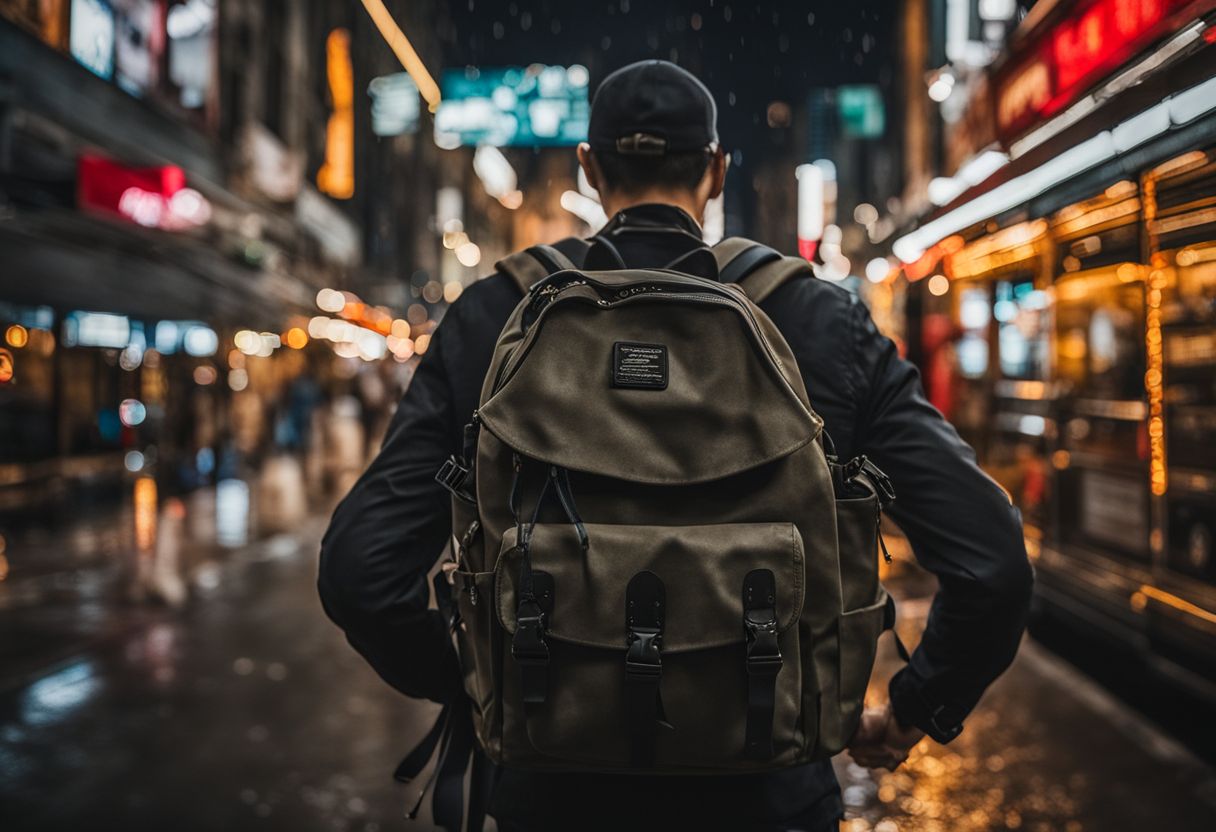Canvas rucksacks, known for their robust fabric and rugged charm, are often the topic of debate when it comes to durability. As someone who has spent considerable time exploring various materials used in everyday carry items, I’ve witnessed firsthand how canvas stands up against the wear and tear of daily life.
My experience extends from evaluating countless bags on treks through nature to assessing their performance in urban jungles, giving me a wealth of practical knowledge about what makes a backpack endure over time.
This article peels back the layers on canvas rucksacks to determine if they truly marry style with substance. Woven into this exploration is an important fact: Canvas backpacks have evolved from mere fashion statements into essential gear that can withstand diverse environments without sacrificing modern aesthetics.
Keep reading as we unravel the tapestry of canvas durability—your ultimate guide awaits just ahead!
Key Takeaways
- Canvas rucksacks are durable due to the tightly woven cotton or linen fabric, making them strong and resistant to wear and tear.
- Waterproof canvas backpacks offer reliable protection against the elements, ensuring the safety of belongings even in challenging weather conditions.
- Regularly applying waterproofing treatment at home and following proper care measures can extend the lifespan of canvas rucksacks.
- While heavy and less breathable compared to some alternatives, canvas rucksacks provide versatility, easy maintenance, and a ruggedly stylish option for everyday use.
Understanding Canvas Material

Canvas material is a strong and durable fabric that has been used for centuries in various applications, including tents, backpacks, and clothing. It is known for its excellent water resistance properties and natural breathability, making it a popular choice for outdoor gear.
Factors such as the weaving process and wax coatings can influence the level of waterproofing in canvas materials.
Origins and common uses
People have used canvas for a long time because it is strong and lasts well. It’s made by weaving cotton or linen very tightly. This makes the fabric tough, which is why it’s great for making things like tents, sails, and backpacks that need to stand up to wear and tear.
Over time, people found out that if you add wax to canvas, it becomes even better at stopping water from getting through. That’s how waxed canvas came about.
Today, many kinds of bags are made out of this material because it can take a lot of use without breaking down. You’ll see canvas rucksacks everywhere – students carry their books in them; hikers use them on trails; travelers love them for their toughness.
They’re also popular for everyday use since they match with lots of different outfits and come in handy when you need something reliable to hold your stuff like laptops or wallets.
Brands like Fjallraven and Terra Thread offer bags made from organic cotton canvas that focus not just on durability but also on being kind to the environment.
Key properties
Canvas is a strong fabric because it’s made from cotton or linen sewn together in a way that makes it thick. It usually has between 50 to 100 threads in each inch of the cloth, which helps make sure the material can take a lot of wear and tear.
Since canvas gets treated with wax, it becomes water resistant. This treatment means rain won’t soak through your bag right away.
This tough fabric doesn’t just keep water out; it also stands up well against scratches and tears. That’s why you often find canvas used for making tents, sails, and even shoes that need to last.
But even with all this strength, canvas is still light enough to carry around easily as a backpack on your adventures.
Factors influencing waterproofing
Waterproofing in backpacks can change based on things like how thick the fabric is and what it’s made of. A canvas that has a lot of threads packed together generally keeps water out better.
If you add wax or other treatments to canvas, this makes it even stronger against rain and spills. But remember that not all canvas is ready to block water right away. When cotton canvas gets mixed with man-made stuff, its ability to stop water drops.
Look after your waterproof gear well to keep them tough against the wet. Simple steps at home can boost their power to hold off water. Use sprays or waxes made for this job; they lock out moisture and help your rucksack last longer in rainy weather or damp places.
Plus, these extras might also fight off dirt and smells which is great for items you use every day.
Pros and Cons of Waterproof Canvas Backpacks

Canvas rucksacks offer durability, protection from the elements, and versatile functionality. However, they may be heavy and lack breathability.
Advantages: Durability, protection, versatility, low maintenance
Canvas backpacks offer several advantages that make them a popular choice for outdoor enthusiasts and travelers. These advantages include:
- Durability: Canvas material is exceptionally strong and resilient, providing excellent long-term use and resistance to wear and tear.
- Protection: Waterproof canvas backpacks offer reliable protection against the elements, ensuring the safety of your belongings even in challenging weather conditions.
- Versatility: With a variety of sizes and designs available, canvas backpacks are versatile and can accommodate different needs and preferences, making them suitable for various activities and adventures.
- Low maintenance: One significant advantage of waterproof canvas backpacks is their minimal care requirements, allowing for easy upkeep and effortless cleaning to maintain their quality over time.
Disadvantages: Weight, breathability, aesthetics
Canvas backpacks have several drawbacks that potential buyers should consider before purchasing. Here are the key disadvantages of waterproof canvas rucksacks:
- Weight: Due to the dense and sturdy nature of canvas material, backpacks made from it tend to be heavier compared to other materials like nylon or polyester. This can be a downside for individuals looking for a lightweight option for carrying their belongings.
- Breathability: Canvas is not known for its breathability, especially when it has been treated with waterproof coatings like wax. This can lead to discomfort during hot weather or prolonged use, as moisture and heat can get trapped inside the bag.
- Aesthetics: While some may find the rugged and vintage look of canvas appealing, others might perceive it as less stylish or modern compared to alternative materials like nylon or tarpaulin. The appearance of canvas may not suit everyone’s taste or fashion preferences.
Care and Maintenance of Waterproof Canvas Backpacks
To maintain the durability and waterproof properties of canvas backpacks, regularly apply a waterproofing treatment at home. When cleaning, use a mild detergent and avoid machine washing to prevent damage to the fabric.
Proper storage in a dry area can also extend the lifespan of your canvas rucksack.
How to waterproof at home
To waterproof a canvas rucksack at home, follow these steps:
- Clean the Backpack:
- Gently brush off any dirt or debris from the surface of the backpack.
- Use a damp cloth and mild soap to wipe down the entire bag, removing any stains or grime. Allow it to dry completely.
- Apply Waterproofing Solution:
- Choose a high – quality waterproofing spray or wax specifically designed for canvas material.
- In a well – ventilated area, evenly apply the waterproofing solution to the entire backpack using long, sweeping motions.
- Pay extra attention to seams, zippers, and pockets as these areas are more prone to leakage.
- Let It Dry:
- Allow the waterproofing solution to dry thoroughly according to the manufacturer’s instructions. This often involves leaving the backpack in a well-ventilated area for several hours or overnight.
- Test for Effectiveness:
- Sprinkle some water on different parts of the backpack to ensure that the waterproofing treatment has been successful.
- If water beads up and rolls off the surface, then your canvas rucksack is effectively waterproofed.
- Repeat as Necessary:
- Depending on usage and exposure to moisture, reapply the waterproofing solution periodically to maintain optimal water resistance.
How to extend lifespan
Canvas backpacks can last for many years with proper care and storage. Here are some tips to extend the lifespan of your waterproof canvas backpack:
- Clean it regularly: Use a soft brush or damp cloth to remove dirt and stains. Avoid using harsh chemicals that can damage the material.
- Waterproofing: Reapply waterproofing spray or wax to maintain the bag’s resistance to water and moisture.
- Air dry: After cleaning, allow the backpack to air dry completely before storing it. Avoid direct sunlight or heat sources that can cause the material to deteriorate.
- Store properly: When not in use, store the backpack in a cool, dry place away from direct sunlight. Don’t fold or compress it for long periods as this can lead to creases and weakening of the fabric.
- Avoid overloading: While canvas is durable, overloading the backpack can strain the seams and zippers, leading to premature wear and tear.
- Handle with care: Be mindful of sharp objects or rough surfaces that can scratch or puncture the material. Gentle handling can prevent unnecessary damage.
- Check for wear: Regularly inspect the backpack for any signs of wear, such as fraying stitches or weak spots, and address them promptly to prevent further damage.
- Customization considerations: If your canvas backpack has been customized with embroidery or appliques, take extra care when cleaning and storing to preserve these additions without compromising the bag’s integrity.
Alternatives to Canvas for Waterproof Backpacks
Explore the durability, weight, and breathability of nylon, polyester, and tarpaulin materials for waterproof backpacks. Discover the factors to consider when choosing the right material for your needs.
Read on to make an informed decision for your next backpack purchase.
Nylon, polyester, and tarpaulin
Nylon, a popular material for backpacks, offers high strength compared to canvas and polyester. It’s about twice as strong as cotton canvas for the same amount of material. On the other hand, polyester, the second most common material in backpacks after nylon, is known for its durability.
However, test results suggest that it may not be as durable as nylon or canvas when exposed to wear and tear. Tarpaulin is also gaining recognition as an alternative for waterproof backpacks due to its water-resistant properties.
For anyone considering a new waterproof backpack, understanding the differences between these materials is crucial in making an informed choice that aligns with their specific needs and priorities.
Comparison in terms of durability, weight, and breathability
In the quest for a waterproof backpack that stands the test of time, weight, and the elements, discerning outdoor enthusiasts often compare materials like canvas, nylon, polyester, and tarpaulin. Each fabric presents a unique combination of features; let’s examine how they stack up in terms of durability, weight, and breathability.
| Material | Durability | Weight | Breathability |
|---|---|---|---|
| Canvas | Highly durable with exceptional firmness and sturdiness. Waxed canvas offers water resistance and improved durability but has lower abrasion resistance than some synthetics. | Heavier compared to synthetic materials due to its dense weave. | Low, especially if waxed for waterproofing. |
| Nylon (Cordura) | Very durable with excellent abrasion resistance, often utilized in high-end backpacks. | Lighter than canvas, contributing to a more comfortable carry. | Higher than canvas, with some nylon fabrics offering mesh designs for added airflow. |
| Polyester | Strong and resilient, though generally less durable than nylon or high-quality canvas. | Lightweight, offering ease of mobility and handling. | Varies depending on the weave and treatment but usually more breathable than canvas. |
| Tarpaulin | Robust and waterproof, ideal for severe weather conditions but can be less breathable than other materials. | Can be heavy, impacting the overall comfort during extended wear. | Least breathable among the options, making it less suitable for high-exertion activities. |
Choosing the right material for a backpack often involves weighing trade-offs. Canvas excels in durability and sturdiness, yet falls short on weight and breathability—factors that are critical when comfort and long treks come into play. On the other hand, nylon and polyester provide a lighter alternative that aids in ventilation but may sacrifice some durability. Tarpaulin is unbeatable for waterproofing, though it is the heaviest and least breathable. When selecting your next backpack, consider your priorities and the nature of your adventures to determine which material aligns with your goals.
Factors to consider when choosing the right material for a backpack
Factors to consider when choosing the right material for a backpack:
- Durability: Look for materials like nylon, polyester, or waxed canvas that are known for their strength and resistance to wear and tear.
- Water Resistance: Consider the level of waterproofing needed based on your activities and climate conditions. Waxed canvas and certain synthetic materials offer excellent water resistance.
- Weight: Evaluate the weight of the material in relation to your needs – lighter materials like nylon or polyester are preferred for trekking and outdoor activities.
- Breathability: Assess how well the material allows air to pass through, especially important for long-duration wear in warmer climates or during physical activities.
- Aesthetics: Consider the visual appeal of the material, as well as its ability to maintain color vibrancy over time.
Conclusion
In conclusion, canvas rucksacks are a durable choice for those seeking versatility and easy maintenance. While not completely waterproof, they can be treated to resist water to some extent.
The sturdy and adaptable nature of canvas makes it a practical option for travel and day-to-day use. Consider the functional advantages and modern style of canvas rucksacks when choosing your next backpack.
FAQs
1. What makes canvas rucksacks a good choice for carrying things?
Canvas rucksacks are strong and can last a long time, making them great for school or camping trips.
2. Are canvas rucksacks easy to keep clean?
Yes, you can easily take care of your canvas bag by doing simple hand washing or putting it in the laundry with your clothes.
3. Can buying a canvas rucksack help the environment?
Canvas bags are often made from hemp which is biodegradable and uses less energy than materials like nylon that come from fossil fuels.
4. Where can I buy a durable canvas rucksack online?
You can find these kinds of bags on online marketplaces like Amazon, Etsy, or REI where they sell many types of backpacks.
5. What should I look for when choosing an eco-friendly canvas rucksack?
Look for one made from renewable resources and check if it’s fair trade to make sure it’s environmentally friendly and kind to workers.
6. Can a canvas rucksack protect my stuff inside?
Many times they have UV protection to guard against sun damage and cushioning to keep your belongings safe inside.

